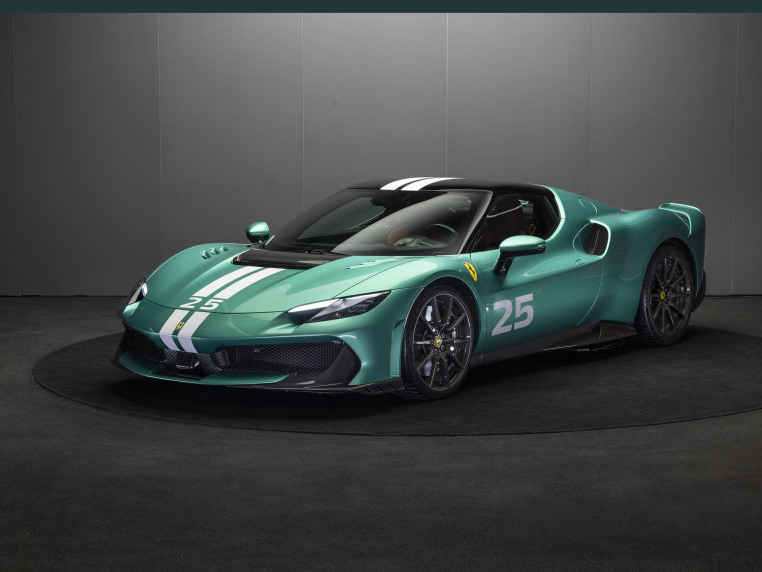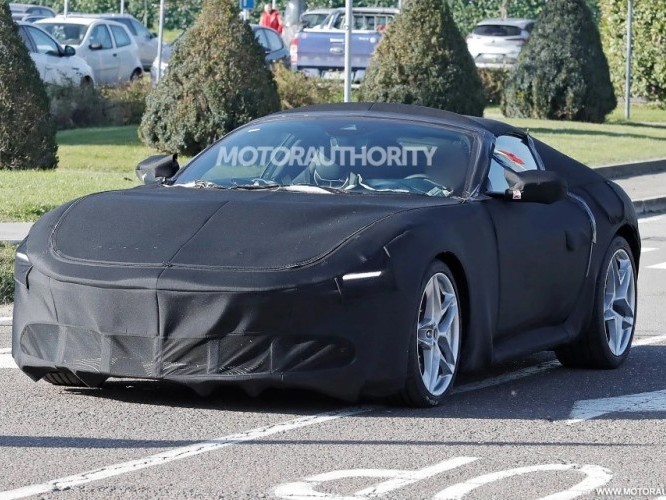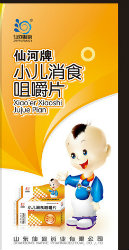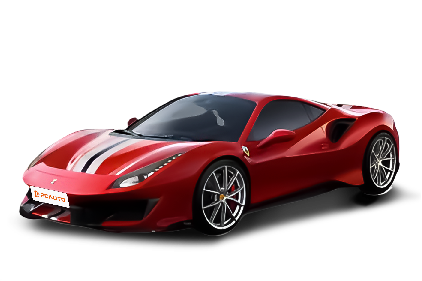Q
How many Ferrari 488 in the world?
As a classic mid - engined V8 supercar series under the brand, the global production volume of the Ferrari 488 is approximately 11,000 to 12,000 units. The specific figure covers different versions such as the 488 GTB, 488 Spider, and the track - exclusive 488 Pista. Among them, the standard 488 GTB accounted for a relatively large proportion during its production from 2015 to 2019. This car is equipped with a 3.9 - liter twin - turbocharged V8 engine, with a maximum horsepower of 670. It's a landmark model for Ferrari's transition to the turbo era. Its successor, the F8 Tributo, further optimizes performance and aerodynamic design.
For car enthusiasts in Malaysia, the 488 is a rare vehicle. Due to factors like import tariffs, the number of these cars in the country is even more limited. They usually appear at high - end automotive events or in the garages of the wealthy. If you want to experience it in person, you can keep an eye on supercar exhibitions in places like Kuala Lumpur or Penang. Meanwhile, Ferrari's official dealers in Malaysia can also provide maintenance services and historical information about relevant models.
Special Disclaimer: This content is published by users and does not represent the views or position of PCauto.
Related Q&A
Q
What is the top model of Ferrari 488?
The top model of the Ferrari 488 series is the 488 Pista. This model was launched in 2018. As a high - performance version of the 488 GTB, its name "Pista" means "track" in Italian, fully reflecting its track - oriented design concept.
The 488 Pista is equipped with a 3.9 - liter V8 twin - turbocharged engine. The maximum output power reaches 720 horsepower, and the peak torque is 770 N·m. It can accelerate from 0 to 100 km/h in just 2.85 seconds, and the top speed can reach 340 km/h. Its performance is extremely strong.
This car has been significantly optimized in terms of aerodynamics and lightweight. For example, it adopts a more aggressive front and rear bumper design, makes extensive use of carbon fiber materials, and simplifies the interior. As a result, the overall weight of the vehicle is about 90 kg lighter than that of the 488 GTB.
For car enthusiasts in Malaysia, the 488 Pista is a very rare super - car. Its limited - production status and ultimate performance make it a dream car for collectors and performance enthusiasts. It's worth mentioning that the Ferrari 488 series was replaced by the F8 Tributo in 2019, but the 488 Pista is still regarded as a classic among Ferrari's mid - engined V8 models. Its technology and design concept have also influenced the development of subsequent models.
Q
Why are Ferrari 458 so expensive?
There are mainly several reasons why the Ferrari 458 is so expensive. First of all, it's the brand value. As a top - notch sports car brand, Ferrari has a long history and a strong racing heritage. This endows its models with extremely high collectible value and room for price premiums.
Secondly, the 458 incorporates a large number of cutting - edge technologies. For example, its 4.5 - liter V8 naturally aspirated engine can deliver 570 horsepower. Paired with a 7 - speed dual - clutch transmission, it can accelerate from 0 to 100 km/h in just 3.4 seconds. Such performance is still remarkable even today.
Moreover, the 458 was designed by Pininfarina. Its appearance is highly recognizable and full of Italian aesthetic style. The interior materials and workmanship are of the top - level standard.
In addition, Ferrari's production volume is limited. During its production from 2010 to 2015, only about 30,000 units of the 458 were produced globally. This scarcity further drives up the price. For car enthusiasts in Malaysia, factors such as import duties and luxury taxes also need to be taken into account, which will significantly increase the final selling price.
It's worth mentioning that the 458, as the last mid - engined V8 Ferrari with a naturally aspirated engine, holds a special place in the hearts of car enthusiasts. This is also an important reason for its good resale value. With the trend of electrification, this kind of high - performance pure - fuel sports cars may become even more precious in the future.
Q
When was the Ferrari 488 discontinued?
The Ferrari 488 officially ceased production in 2020. As a classic model in Ferrari's mid - engined V8 sports car series, it made its debut in 2015, replacing the previous 458 Italia. Its successor, the F8 Tributo, was launched in 2019 and gradually took over its market position. The 488 series includes the 488 GTB, 488 Spider, and the high - performance version 488 Pista. It is equipped with a 3.9 - liter twin - turbocharged V8 engine, with a maximum output power of up to 720 horsepower (in the Pista version), making it one of Ferrari's important representative works in turbocharging technology. For car enthusiasts in Malaysia, there is still a certain number of 488s in the local market. Some used cars or display cars may still be available for purchase through authorized dealers or professional channels. In addition, the discontinuation of the 488 also marks that Ferrari's V8 models have entered a new stage. Subsequent models such as the F8 Tributo and SF90 Stradale further integrate hybrid technology and aerodynamic innovations, continuing the brand's leading position in performance and technology.
Q
Who is the rival of the Ferrari 488?
The main competitors of the Ferrari 488 include supercars such as the Lamborghini Huracán, McLaren 720S, and Porsche 911 Turbo S. These models are on the same level as the 488 in terms of performance, design, and brand influence. The Lamborghini Huracán is well - known for its aggressive appearance and V10 engine. The McLaren 720S has become a strong competitor to the 488 with its lightweight carbon - fiber structure and powerful performance. The Porsche 911 Turbo S is famous for its excellent daily driving comfort and all - wheel drive system.
In the Malaysian market, these models are also highly sought after by high - performance car enthusiasts. The local hot climate and diverse road conditions pose higher requirements for the cooling systems and suspension tuning of supercars. Therefore, special attention should be paid to their adaptability when choosing such models. Additionally, the high automotive taxes in Malaysia will significantly increase the selling prices of these imported supercars. However, their rarity and outstanding performance still attract many collectors and car fans.
Q
Which is faster, Ferrari 488 or Lamborghini Huracan?
Both the Ferrari 488 and the Lamborghini Huracán are top - notch supercars, but their performance varies slightly. The Ferrari 488 is equipped with a 3.9 - liter V8 twin - turbocharged engine. It has a maximum horsepower of 670, can accelerate from 0 to 100 km/h in just 3 seconds, and has a top speed of 330 km/h. The Lamborghini Huracán, on the other hand, features a 5.2 - liter V10 naturally aspirated engine. The standard version has 610 horsepower, can accelerate from 0 to 100 km/h in 3.2 seconds, and has a top speed of 325 km/h. Based on the data, the Ferrari 488 has a slight edge in acceleration and top speed. However, the actual driving experience also depends on factors such as the vehicle's tuning, weight distribution, and driving environment. In the tropical climate of Malaysia, turbocharged engines might be affected by high temperatures, while the linear power output of naturally aspirated engines could be more suitable for some drivers. Both cars represent the pinnacle of Italian supercar craftsmanship. The choice between them largely depends on personal preference, whether it's the pursuit of ultimate speed or a unique driving experience. It's worth noting that Malaysia's road conditions and tax policies for high - performance cars also impact the actual usage experience of car owners.
Q
How much does it cost to maintain a Ferrari 488?
In Malaysia, the average annual cost of maintaining a Ferrari 488 is approximately between RM50,000 and RM100,000. The specific cost depends on the vehicle's usage frequency and maintenance items. Routine maintenance such as oil changes and filter replacements typically costs around RM5,000 to RM8,000 each time. More complex services like gearbox inspections or brake system maintenance can cost as much as RM15,000 to RM30,000. Tire replacement is also a significant expense. A set of high - performance tires usually costs around RM20,000 to RM40,000.
In addition, as a high - end brand, Ferrari recommends that owners go to the official authorized service centers for maintenance to ensure professionalism and the use of original parts. Although the cost is relatively high, it can guarantee the long - term performance and resale value of the vehicle. For potential buyers, insurance costs also need to be considered. The annual insurance premium for such supercars may exceed RM30,000, depending on the driving record and insurance coverage.
After understanding these costs, owners can better plan their budgets. It is also advisable to conduct regular maintenance to avoid higher repair costs. After all, a well - maintained Ferrari not only provides an excellent driving experience but also retains a high value when resold.
Q
Is the Ferrari 488 reliable?
As a high-performance sports car, the Ferrari 488 generally meets its positioning in terms of reliability. However, attention should be paid to the impact of maintenance costs and the usage environment on the vehicle. The 3.9-liter V8 twin-turbocharged engine installed in the 488 is powerful and the technology is mature. But the precise structure of the high-performance engine means that maintenance must be carried out strictly in accordance with the manufacturer's recommendations, especially the regular inspection of the turbo system and the gearbox. In the hot and humid climate of Malaysia, it is recommended to replace the coolant and engine oil more frequently, and pay attention to the moisture-proof treatment of the electronic system to avoid potential problems caused by high temperature and humidity. Compared with ordinary family cars, the replacement cost of high-performance components such as the suspension system and carbon-ceramic brake discs of supercars is relatively high, which is a factor to be considered before purchase. If the car is used on urban roads in Malaysia for a long time, frequent low-speed stops and starts may increase the wear and tear of the clutch. It is recommended to conduct regular computer diagnostics. Among models in the same class, the reliability of the 488 is at the mainstream level. However, the design of supercars focuses more on performance rather than durability, so owners need to have reasonable expectations. For owners who pursue the ultimate driving experience, the 488 is still a worthy option. It is recommended to purchase through official channels and strictly follow the maintenance plan to ensure the best condition.
Q
When did they stop making the Ferrari 488?
The production of the Ferrari 488 officially ended in 2019, and it was then succeeded by the Ferrari F8 Tributo, which serves as the new - generation model in the brand's mid - engine V8 sports car series. The 488 made its debut in 2015, equipped with a 3.9 - liter twin - turbocharged V8 engine with a maximum power of 670 horsepower. It became one of the top - performing models in its class at that time and was deeply loved by car enthusiasts in Malaysia.
Its successor, the F8 Tributo, is further optimized in terms of power and aerodynamics. The maximum power has been increased to 720 horsepower, while retaining the classic design elements of the 488. For Malaysian consumers, the 488 is still highly sought after in the second - hand market, especially for its excellent driving experience and the iconic Ferrari engine sound. The launch of the F8 Tributo provides more options for car enthusiasts who pursue the latest technology.
Both the 488 and the F8 Tributo reflect Ferrari's outstanding pursuit of performance and craftsmanship, meeting the needs of Malaysian high - performance car enthusiasts.
Q
How to put a Ferrari 488 in park?
To put the Ferrari 488 into Park, first make sure the vehicle has come to a complete stop. Then, press and hold the brake pedal. Next, press the "P" button on the center console to activate the electronic parking system. At this time, the transmission will lock, and the "P" gear indicator will appear on the dashboard. It should be noted that the Ferrari 488 is equipped with a dual - clutch transmission (F1 DCT) and doesn't have the traditional mechanical gear lever of an automatic transmission. All gear - shifting operations are done through electronic buttons or paddles. Therefore, when parking, there's no need to shift gears like in traditional models; just press the "P" button.
For Malaysian owners, when parking a super - car for a long time in the hot and rainy climate, it is recommended to activate the electronic handbrake (if available) on a flat surface and avoid long - term exposure to the sun to protect the transmission and electronic systems. In addition, the transmission of high - performance models like Ferrari is designed to focus more on track performance. During daily driving, it is advisable to come to a complete stop before shifting into Park to avoid unnecessary load on the transmission system. If you encounter a situation where you can't shift gears, it may be that the electronic system needs to be restarted or checked. In this case, you can try turning off the vehicle and restarting it.
Q
What's better, Ferrari 458 or 488?
Both the Ferrari 458 and 488 are outstanding supercars, yet they are designed for different driving needs and eras. The 458 is equipped with a 4.5 - liter naturally - aspirated V8 engine, offering more direct throttle response and a classic high - revving engine sound, which is perfect for car enthusiasts who pursue pure driving pleasure. On the other hand, the 488 features a 3.9 - liter twin - turbocharged V8 engine. It has stronger power and earlier torque delivery, with a 0 - 100km/h acceleration time of just 3 seconds, making it more suitable for buyers who seek ultimate performance.
In the hot climate of Malaysia, the turbo system of the 488 may be more adaptable to low - speed driving, but the naturally - aspirated engine of the 458 is more charming at high revs. Both cars are equipped with Ferrari's top - notch chassis tuning. The 458 has more mechanical and direct steering feedback, while the 488 focuses more on daily driving comfort. Considering the road conditions in Malaysia, the 488 might be more suitable for daily use, but the 458 has a higher collectible value.
These two cars represent the pinnacle of Ferrari's mid - mounted V8 engines. The choice depends on whether you prefer the classic naturally - aspirated experience or the modern turbocharged one.
Latest Q&A
Q
What is the CC of Honda City 2020?
The 2020 Honda City hits the Malaysian market with two engine choices: a 1.5-liter SOHC i-VTEC naturally aspirated petrol engine and a 1.5-liter DOHC i-VTEC hybrid system. Let's break down the specs. The petrol unit displaces 1497cc, cranking out 121 horsepower and 145 Nm of torque. On the hybrid side, it pairs that same 1.5-liter engine with an electric motor, resulting in a combined 109 horsepower – this one's all about fuel sipping efficiency.
Now, CC (cubic centimeters) is the measure of engine displacement, and it directly impacts how a car performs and drinks fuel. Typically, a bigger displacement means more power, but it can also mean higher fuel bills. The City's 1.5-liter sweet spot is a big reason it's so popular in Malaysia – it strikes that perfect balance between pep and fuel economy, handling both city commutes and longer drives like a champ.
But the 2020 City isn't just about the engine bay. It also comes loaded with Honda Sensing safety tech and a modern, fresh interior design, which really ups its game in the market. For Malaysian buyers, this car ticks all the boxes: practical, easy on the wallet at the pump, and packed with the latest tech. It's a solid all-rounder.
Q
How much does a Honda 2020 cost?
Prices for the 2020 Honda models in Malaysia vary quite a bit depending on the specific model and how it's kitted out. Take the Honda City, for example – you're looking at roughly RM70,000 to RM90,000. The Civic sits a bit higher, usually ranging from around RM110,000 up to RM140,000, while the CR-V typically falls between RM140,000 and RM170,000. exact figures hinge on the trim level, engine specs, and any extra add-ons you might go for.
When buying a new car in Malaysia, it's not just the sticker price you need to factor in. There's registration fees, insurance, road tax – all that extra stuff adds up and affects the final on-the-road cost.
Over in the used car market, 2020 Honda models will fluctuate in price too, based on mileage, condition, and remaining warranty. You can generally pick one up for 20% to 40% less than a brand-new equivalent.
If you're in the market, I'd definitely recommend shopping around different dealers to compare quotes. It's also worth checking out any ongoing Honda promotions or financing deals – those can really help you save some cash.
Hondas have a solid rep in Malaysia for being reliable and fuel-efficient, especially popular models like the City and Civic. They're pretty affordable to own long-term, and getting them serviced or repaired is relatively straightforward.
Q
What is the top speed of Honda City 2020?
The 2020 Honda City maxes out at around 190 km/h, which is the top speed you can squeeze out of its 1.5-liter i-VTEC naturally aspirated engine under ideal conditions. Of course, in the real world, you might see a slight difference depending on road conditions, how much you're carrying, or the weather. This car is pretty popular in the Malaysian market, and it's not just because of its solid performance—it's also about that fuel efficiency and nimble handling that makes city driving a breeze. The CVT gearbox in the City does a good job smoothing out power delivery, so acceleration feels seamless and efficient, whether you're commuting daily or hitting the highway for a longer drive. For Malaysian buyers, beyond just top speed, overall performance and maintenance costs matter a lot, and the City delivers here too. Its low trouble rate and wide service network make life easier for owners. If you're craving a bit more zip, there's always the Honda City RS variant. It gets some tweaks to the engine tuning and sportier bits, but don't expect a huge jump in top speed—these cars are all about balancing practicality with a bit of driving fun, after all.
Q
How safe is the Honda City 2020?
The 2020 Honda City holds its own when it comes to safety, packing in 6 airbags, Vehicle Stability Assist (VSA), Anti-lock Braking System (ABS), and Electronic Brake-force Distribution (EBD). That's a pretty solid setup for the class, and it should do a good job of keeping you protected during those daily drives around Malaysia. Honda's ACE Body Structure is also on board here, which is designed to effectively disperse crash energy and boost occupant safety in the event of a collision. It's worth highlighting that the 2020 City scored a 5-star rating in ASEAN NCAP crash tests, which is a solid stamp of approval for its safety credentials. For Malaysian buyers, picking this car means you're not just getting Honda's usual reputation for reliability, but also a decent level of safety kit. If safety is a top priority for you, it's definitely worth checking out the specific safety features when you're looking to buy – things like whether it comes with Honda Sensing. That suite includes handy advanced features like Adaptive Cruise Control and Lane Keeping Assist, which can go a long way in making your drives even safer.
Q
What is the fuel economy of the Honda City 2020?
The 2020 Honda City demonstrates excellent fuel efficiency in the Malaysian market. The variant equipped with the 1.5L i-VTEC petrol engine and CVT transmission has an official combined fuel consumption of 5.4 L/100km (approximately 18.5 km/L). The hybrid e:HEV variant is designed for even higher efficiency, though its specific fuel consumption figure should be verified with official sources or latest reviews, as the widely cited 3.4 L/100km (approximately 29.4 km/L) lacks direct support in the provided search results and may not reflect real-world conditions in Malaysia. Both powertrains closely align with the demands of Malaysian consumers who prioritize fuel economy. Actual fuel consumption may vary depending on factors such as driving habits, road conditions, and vehicle load. Therefore, adhering to a regular maintenance schedule is crucial for maintaining optimal fuel efficiency.
Given Malaysia's hot and humid climate, judicious use of the air conditioning system and maintaining the recommended tire pressure can contribute significantly to improving fuel economy. As a top-selling model in the B-segment sedan market in Malaysia, the Honda City's fuel efficiency remains competitive against its peers, making it a practical choice for daily commuting and family use. The e:HEV hybrid version, in particular, presents a compelling option for environmentally conscious drivers seeking to minimize long-term running costs, pending verification of its specific fuel economy claims.
View MoreRelated News

Ferrari unveils the chassis and core components of its first all-electric model, Elettrica
LienOct 10, 2025

Ferrari 849 Testarossa officially released, succeeding the SF90 Stradale with more powerful performance
RobertSep 12, 2025

Ferrari Unveils 296 Speciale Plug-in Hybrid Supercar, Accelerating from 0-100 km/h in Just 2.8s
JohnApr 30, 2025

Meet Ferrari's New Track Beast: 296 VS Debuts on April 29
RobertApr 3, 2025

Spy shots of the Ferrari Roma successor revealed! May be released by the end of 2025, Hybrid system could be the highlight
WilliamNov 19, 2024
View More


















Pros
Cons